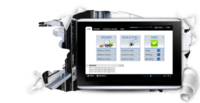-
USDA gives GenVec conditional approval for FMD vaccine for cattle
The USDA has issued a conditional license for GenVec’s foot-and-mouth disease (FMD) vaccine for use in cattle; GenVec’s cell line is capable of producing antigens without the use of the highly contagious FMD virus; because the vaccine is produced without using live or killed virus materials, it can be produced cost effectively in the United States and around the world
-
-
A record: half of U.S. land area is in various stages of drought

Analysis of the latest drought monitor data revealed that 46.84 percent of the U.S. land area is in various stages of drought, up from 42.8 percent a week ago; previous records were 45.87 percent in drought on 26 August 2003, and 45.64 percent on 10 September 2002; looking only at the forty-eight contiguous states, 55.96 percent of the country’s land area is in moderate drought or worse — also the highest percentage on record
-
-
U.K. potential food crisis
Many climate experts believe a slight rise in U.K. temperatures would be beneficial for the farming industry as yields could increase; as temperatures continue to rise, however, farmers would need to use more and more fertilizer on their crops and some livestock would not be as productive; consumers could thus face reduced food choices
-
-
Even a limited India-Pakistan nuclear war would substantially reduce global crop yields

Worries about nuclear winter have faded since the end of the cold war, but existing stockpiles of nuclear weapons still hold the potential for devastating global impacts; researchers have found that the climate effects of a hypothetical nuclear war between India and Pakistan would greatly reduce yields of staple crops, even in distant countries
-
-
Developing a new test for safer milk
Brucellosis is the most common animal-to-human infection worldwide, with more than 500,000 new cases reported each year; it rarely causes death, but it can result in prolonged health problems; researchers received a 3-year grant of $500,000 from the U.S. Department of Agriculture to develop a new technology that can rapidly test milk and other dairy products for harmful pathogens
-
-
USDA releases requests for applications for the AFRI food safety challenge
The Department of Agriculture’s National Institute of Food and Agriculture says that this year’s grants under the Agriculture and Food Research Initiative will focus on promoting and enhancing the scientific discipline of food safety, with an overall aim of protecting consumers from microbial, chemical, and physical hazards that may occur during all stages of the food chain, from production to consumption
-
-
Do nano-pesticides hold promise or pose threat to greener agriculture?
Nanotechnology has developed significantly in the past decade and was able to create many new materials with a vast range of potential applications; the risk that nano-particles may pose to human and environment health, however, is not yet fully understood; a precautionary principle suggests keeping environmental release of nano-particles minimal until their fate and toxicity is better understood
-
-
New salmonella species food safety test kit
Salmonella is a genus of bacteria that are a major cause of foodborne illnesses throughout the world. The bacteria are generally transmitted to humans through the consumption of contaminated food; new salmonella test kit unveiled
-
-
Global food-trade network vulnerable to fast spread of contaminants
As the world’s population climbs past seven billion, the sustainable production and distribution of food is balanced against the need to ensure its chemical and microbiological safety; this is not easy: a rigorous analysis of the international food-trade network shows the network’s vulnerability to the fast spread of contaminants as well as the correlation between known food poisoning outbreaks and the centrality of countries on the network
-
-
Veterinary profession trends short-change biosecurity, food security, public health
More than half of veterinary students in the United States seek training in companion animal or pet medicine – with fewer and fewer graduate veterinary students pursuing Ph.D. training which would prepare them for academic careers, key jobs in the public sector, and some positions in industry; the result is a dwindling supply of veterinarians to fill jobs overseeing and enforcing food safety and animal health standards, conduct research in human drug development and advances in pet health, and participate in wildlife and ecosystem management, infectious disease control, biosecurity, and agro-terrorism prevention
-
-
Making food, water supply safe is a challenge for today's sensors
Sensors that work flawlessly in laboratory settings may stumble when it comes to performing in real-world conditions; these shortcomings are important as they relate to safeguarding the U.S. food and water supplies
-
-
New devices tests food for safety, quality
A new spectrometer will allow consumers to gage the quality of food before they buy it; the device is no bigger than a sugar cube, is inexpensive to manufacture, and could one day be installed in smartphones
-
-
New app to keep food safer

FoodCheck, an application developed for Android tablet devices, can minimize dangerous and costly errors in food preparation by automating the process of controlling and monitoring food by using wireless temperature monitoring
-
-
USDA announces fourth Mad Cow case
The U.S. Department of Agriculture (USDA) has announced it had identified a cow suffering from mad cow disease, or bovine spongiform encephalopathy (BSE); this is the fourth case of mad cow disease found in the United States since 2003, and the first since 2006
-
-
Using mathematics to feed the world
In the race to breed better crops to feed the increasing world population, scientists at the University of Nottingham are using mathematics to find out how a vital plant hormone affects growth
-
- All
- Regional
- Water
- Biometrics
- Borders/Immig
- Business
- Cybersecurity
- Detection
- Disasters
- Government
- Infrastructure
- International
- Public health
- Public Safety
- Communication interoperabillity
- Emergency services
- Emergency medical services
- Fire
- First response
- IEDs
- Law Enforcement
- Law Enforcement Technology
- Military technology
- Nonlethal weapons
- Nuclear weapons
- Personal protection equipment
- Police
- Notification /alert systems
- Situational awareness
- Weapons systems
- Sci-Tech
- Sector Reports
- Surveillance
- Transportation
Advertising & Marketing: advertise@newswirepubs.com
Editorial: editor@newswirepubs.com
General: info@newswirepubs.com
2010-2011 © News Wire Publications, LLC News Wire Publications, LLC
220 Old Country Road | Suite 200 | Mineola | New York | 11501
Permissions and Policies
Editorial: editor@newswirepubs.com
General: info@newswirepubs.com
2010-2011 © News Wire Publications, LLC News Wire Publications, LLC
220 Old Country Road | Suite 200 | Mineola | New York | 11501
Permissions and Policies
